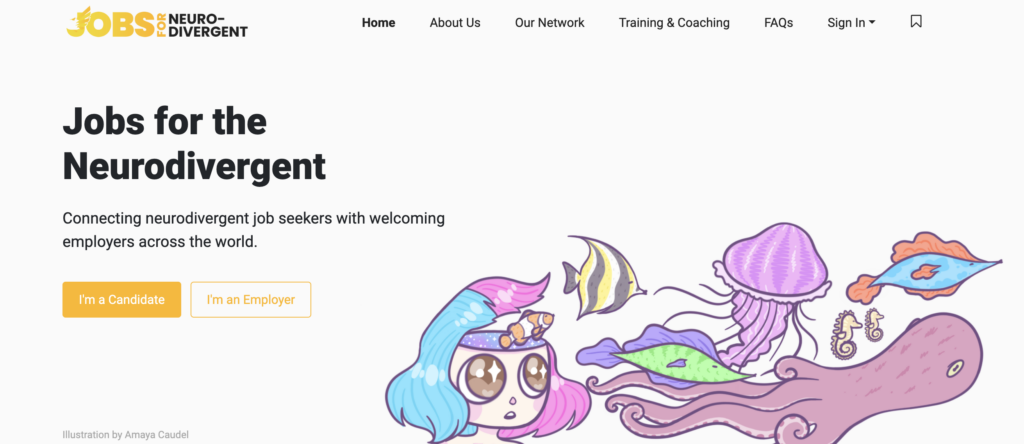
Neurodiversity was first coined by Australian sociologist Judy Singer in the late 1990s. In her book, Neurodiversity: The birth of an idea, she explored the concept of biodiversity and how it applied to the neurocognitive variability found in humans. Singer’s interest in the subject was personal, as she herself came from a family of neurodivergent. She believed that by reducing stigmas associated with it, businesses, and indeed society as a whole, would benefit greatly.
Neurodivergence is the term for when someone’s brain processes, learns, and/or behaves differently from what is considered typical.
In a nutshell, for those not completely familiar with the concept of neurodiversity: neurodivergence is the term for when someone’s brain processes, learns, and/or behaves differently from what is considered typical. There’s different types of neurodiversity, but they include autism, ADHD, Dyslexia, Highly Sensitive Person (HSP), Learning disabilities and many more.
Jobboard for neurodivergent
Among those who were neurodiverse? Albert Einstein, Henry Ford, Alan Turing and Bill Gates — just to name a few. But unemployment among the neurodiverse population runs as high as 80%, as per the HBR. It prompted Jobs for Humanity, an international movement aiming to connect historically underrepresented talent to employers, to come up with its own jobboard for the neurodivergent: Jobs for the Neurodivergent.
“On average, almost 1 billion people are neurodivergent.”
“On average, almost 1 billion people are neurodivergent”, Roy Baladi, the founder of Jobs for Humanity, commented. “It is a term that refers to a variation in brain composition that affects things like learning, sociability and mood. Beyond a platform for jobs, we offer online and expert coaches covering the knowledge gap between talent and employers. It covers top blind spots and challenges, how to interview to look for skills and potential, reasonable accommodations and assistive technologies, how to keep supporting if you do not hire the candidate and how to onboard and support long term if you do hire.”
Stigmas around neurodiversity remain
Despite efforts from many, we’re nearly at the thirty-year mark after Singer’s first attempt at coining the term. While neurodiversity has gained popularity across the globe, the stigmas still largely persist. Employers are excluding neurodiverse individuals. That’s how the executive summary of the 2023 EqualTech report conducted by Sparta Global starts. In 2022, the research company surveyed more than 500 individuals across almost every industry sector to try to gain a better understanding as to why the exclusion still persists.
“The neurodiverse community offers a mass of untapped potential with fresh thinkers who bring unique and powerful perspectives to our industry.”

“In an industry such as technology where there is a significant skills gap, and employers are crying out for innovative talent. The neurodiverse community offers a mass of untapped potential with fresh thinkers who bring unique and powerful perspectives to our industry”, Purnima Sen, Chief People and ED&I Officer Sparta Global commented. “So why are companies in this sector still failing to take positive action?”
Awareness not yet translating into action
In their survey, Sparta Global found that 87% of digital leaders believe neurodiversity will be a ‘top priority’ for their companies in 2023. “This signals that digitally driven businesses are increasingly aware of the importance of neurodiversity, which is viewed as a strategic objective for Equality, Diversity and Inclusion (ED&I).” But saying and doing are two different things, the report sees. While awareness may be on the rise, that doesn’t mean it translates into action. 68% of digital leaders said that they don’t think their organisation is currently doing enough to remove barriers to entry for neurodiverse talent.
Five simple tips for recruiting
When it comes to recruiting neurodiverse talent, there’s plenty of easy fixes. Particularly in job ads, which tend to be full of long lists and avoidable jargon, the research points out. We’ve accumulated all five of them below.
1. Be specific
Most job ad writers do love a long list of skills, which may or may not be necessary in order to succeed in any given role. Time to stop that, the report says. “Avoid a long list of skills if they are not necessary for the role. Instead, be specific: indicate which ones are “must-haves” and which ones are “nice to haves”. Focus on what is important and required for the job.”
2. Get rid of the superlatives
Superlatives and exaggerated terms are usually avoidable. And even more so when it comes to the recruiting of neurodiverse talent. “Stop using “world-class”, “industry-leading”, “coding wizard”, and “tech guru”. Instead, aim to spell out exactly which competencies are needed and their relevance within the specific context of the job you are advertising.”
3. Avoid ‘flexible’ and ‘dynamic’
While there’s a much larger debate around the usage of words that leave room for interpretation — or don’t really mean anything at all, Sparta Global sees reason to avoid using words that may be difficult to interpret. “Words such as “flexible” or “dynamic”. Instead, be clear about what is intended: what do “flexibility” or “dynamism” mean in practice?”
4. Choose consistent colours
Something being readable is always good. But particularly for neurodivergent candidates, which can be more sensitive to sensory stimulation, it’s important to consider readability. “This includes fonts, colours, and paragraphs. Choosing a consistent colour scheme with a good contrast ratio and avoiding pictures obscuring the words can drastically improve the readability of your job ads. It also helps to break your text into shorter paragraphs and bullet points to draw attention to important information.”
5. Show you’re committed
Again: saying and doing are two different things, but stating your intentions goes a long way, the report notes. “Take the opportunity to clearly state that you care about neurodiversity. For example, you could explain that your company is committed to digital equality and that it encourages and values applications from neurodivergent thinkers.”
Read more
- Jobs for Humanity launches third unique job board for the neurodivergent
- What is talent intelligence and how can Europe’s talent leaders benefit from it?







